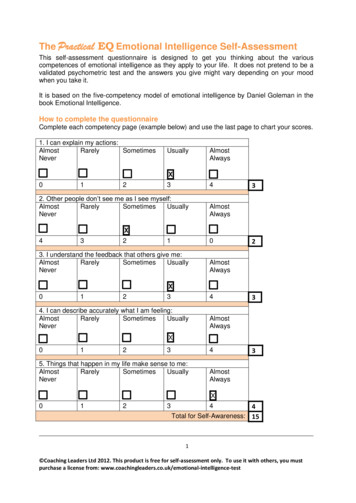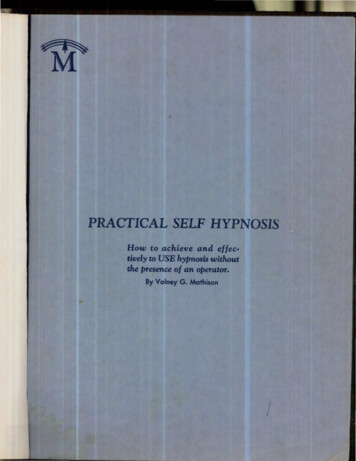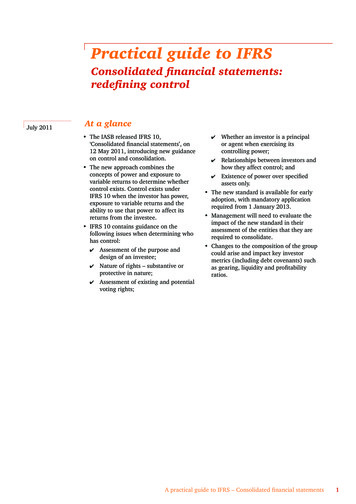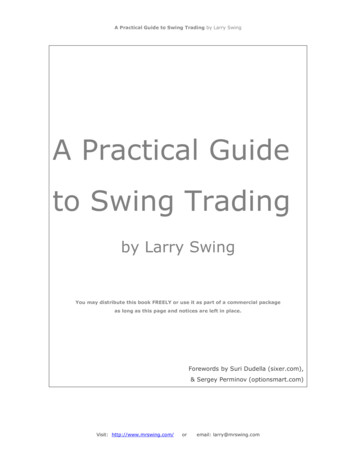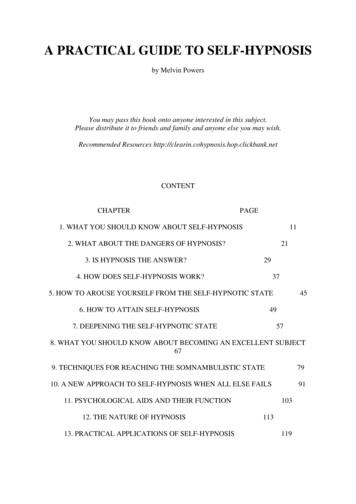
Transcription
A PRACTICAL GUIDE TO SELF-HYPNOSISby Melvin PowersYou may pass this book onto anyone interested in this subject.Please distribute it to friends and family and anyone else you may wish.Recommended Resources CHAPTERPAGE1. WHAT YOU SHOULD KNOW ABOUT SELF-HYPNOSIS112. WHAT ABOUT THE DANGERS OF HYPNOSIS?3. IS HYPNOSIS THE ANSWER?21294. HOW DOES SELF-HYPNOSIS WORK?375. HOW TO AROUSE YOURSELF FROM THE SELF-HYPNOTIC STATE6. HOW TO ATTAIN SELF-HYPNOSIS45497. DEEPENING THE SELF-HYPNOTIC STATE578. WHAT YOU SHOULD KNOW ABOUT BECOMING AN EXCELLENT SUBJECT679. TECHNIQUES FOR REACHING THE SOMNAMBULISTIC STATE7910. A NEW APPROACH TO SELF-HYPNOSIS WHEN ALL ELSE FAILS9111. PSYCHOLOGICAL AIDS AND THEIR FUNCTION12. THE NATURE OF HYPNOSIS13. PRACTICAL APPLICATIONS OF SELF-HYPNOSIS103113119
FOREWORDAll of us like to think that our actions and reactions are a result oflogical thought processes, but the fact is that suggestion influencesour thinking a great deal more than logic. Consciously or unconsciously,our feelings about almost everything are largely molded by ready-madeopinions and attitudes fostered by our mass methods of communication. Wecannot buy a bar of soap or a filtered cigarette without paying tributeto the impact of suggestion. Right or wrong, most of us place moreconfidence in what "they" say than we do in our own powers of reason.This is the basic reason why psychiatrists are in short supply. Wedistrust our own mental processes and want an expert to tell us what tothink and feel.Despite this tendency to adopt our attitudes from others, man has alwaysbeen dimly aware that he can influence his own destiny by directing histhoughts and actions into constructive channels. He has always, to someextent, known that his mind exerts a powerful influence on his body, andthat thoughts can have harmful or helpful effects on his emotional andphysical health. The ancient Egyptian sleep temples and the attempts byearly physicians to drive evil spirits out of the body were bothattempts to influence the body through the mind.The unprecedented sale of The Power of Positive Thinking by NormanVincent Peale and other inspirational literature proves that millions ofmodern people recognize the efficacy of constructive thoughts. What mostof them do not recognize is that they are capable of implanting thesebeneficial thoughts in their own minds without reference to any outsideagencies. This can be done through self-hypnosis.In modern society we have many cults, religions and methodologies whichhave mental discipline as their goal. The best example of a methodologyis psychosomatic medicine which deals with the interrelationship of themind and body in the production of mental or physical illness. The rapidgrowth of hypnosis in the last few years is another example, and it isgratifying to see that the emphasis in this field is now shifting fromhetero-hypnosis to self-hypnosis.Self-hypnosis is a highly suggestible state wherein the individual candirect suggestions to himself. It is a powerful tool in any therapeuticprocess, and highly motivated subjects can parallel the success ofhetero-hypnosis through their own efforts. Self-hypnosis can be used asa palliative agent and can even afford lasting results in many areas ofthe organism. Self-hypnosis can alleviate distressing symptoms,substitute strong responses for weak responses, help overcome badhabits, create good habits and help one's power of concentration. Thetotal personality is eventually changed to the point where it can
function adequately in an increasingly difficult environment.In learning self-hypnosis, the subject does not relinquish control ofhimself as is commonly believed. Actually, more control is gained.Self-sufficiency and self-confidence are inevitable results. It is wellto remember, however, that even good things may be overdone, and goodjudgment is necessary for favorable results. Neither hypnosis norself-hypnosis should ever be used indiscriminately. The effectiveness ofself-hypnosis depends upon many factors. Strong motivation, intelligentapplication of suggestions and diligence are prerequisites.We are not suggesting that self-hypnosis can take the place of all formsof psychotherapy. We do recommend it as an adjunct to therapy whenindicated. Used judiciously, it can contribute a great deal to theindividual's physical and emotional well-being and happiness.As a professional hypnotist for many years, I have seen astounding andapparently miraculous results by individuals using self-hypnosis. Manyof these cases seem unbelievable to those not familiar with hypnoticphenomena. It should be remembered, though, that many individuals seekhypnosis only when all other forms of therapy have failed. This is socommon that hypnosis has come to be known as a port of last call. Yet,despite the seeming hopelessness of such cases, medical literature liststhousands of remarkable recoveries.There is nothing hit or miss about hypnosis. Used intelligently, theresults are the same for all those who are properly motivated. Nor arethe results singular to modern hypnotists alone. In reviewing theliterature going back more than 100 years, the same gratifying resultswere obtained. The reader would do well to scan some out-of-print bookson hypnosis at the library to understand the point further.This book is written in terms that are comprehensible to the layman. Thestep-by-step instructions should afford the reader a means of acquiringself-hypnosis. The necessary material is here. The reader need onlyfollow the instructions as they are given.The author wishes to thank Robert S. Starrett, member of the AmericanMedical Writers' Association, for his valuable help in the editorialpreparation of this book.It is the author's hope that you will, through the selective use ofself-hypnosis, arrive at a more rewarding, well-adjusted and fullerlife.MELVIN POWERS12015 Sherman RoadNo. Hollywood, California 91605
Chapter 1What You Should Know About Self-HypnosisHypnosis has been defined as a state of heightened suggestibility inwhich the subject is able to uncritically accept ideas forself-improvement and act on them appropriately. When a hypnotisthypnotizes his subject, it is known as hetero-hypnosis. When anindividual puts himself into a state of hypnosis, it is known asself-hypnosis. In both cases, the subject has achieved a heightenedstate of suggestibility. Even in hetero-hypnosis, the subject reallycontrols the response to suggestions. Actually, all hypnosis is really amatter of self-hypnosis. The subject enters into the hypnotic state whenhe is completely ready to do so. This may require from one to manyattempts before it is achieved. Even if the subject insists that hewants to be hypnotized immediately, he may be resisting hypnosisunconsciously.In self-hypnosis the same thing usually takes place. The subject isanxious to achieve self-hypnosis, but somehow the state eludes him.What's wrong? It may be that he is unconsciously resisting it, hasn'tconditioned himself sufficiently, or has achieved the hypnotic state anddoesn't know he is in the state. This last statement may be surprising,but we will examine it in detail a little later on.Most experts agree that about 90 percent of the population can behypnotized. My own feeling is that probably 99 percent can behypnotized. Who among us is not influenced by suggestion? Aren't we all,as we have seen, influenced by the suggestions of advertising? Don't weall have a tendency to believe what we read in the paper, hear on theradio or see on television? Aren't we all convinced that a name-brandarticle is better than one that is not so well-known?Suggestion plays a tremendously important role in our daily lives. Itbegins from naming the baby with an appropriate name to securing asuitable place for interment. I would like to call the reader'sattention to a fascinating book dealing with the unconscious reasons whywe do many of the things that we do. You will be intrigued with everypage of the book. It is called The Hidden Persuaders by Vance Packard.My contention is that we are all suggestible and, therefore, beinghypnotized or hypnotizing ourselves is just a matter of increasing thesuggestibility that we already possess. Doesn't the hypnotist begin bysuggesting relaxation? Doesn't he usually begin by requesting thesubject to fix his attention on a particular object? Next, he suggests
to the subject that his eyes are becoming heavy and tired. As soon asthe subject closes his eyes, he suggests that he will be in a deephypnotic state. I am sure that you are familiar with this procedure.With each step, the hypnotist is guiding the subject along directedlines to get him to accept further suggestions without question ordoubt. When the subject achieves the ultimate state in this procedure,he has been hypnotized. He then accepts suggestions withoutequivocation.Let us continue with this same thought. Suppose I say to you, "I'm goingto stick you with this pin. It won't hurt." Would you let me stick youwith the pin? Obviously not. Let us suppose that you have beenhypnotized and I repeat the same suggestion. What happens then? Youreadily accept the suggestion as being factual. Should I proceed tostick you with the pin, you do not even flinch. In fact, you do not evenfeel the pain. Does this sound incredible? Isn't this exactly the sameprocedure that the dentist uses with his patient when he has hypnotizedhim for the purpose of painless dentistry?Achieving hypnosis, therefore, is a matter of directing thissuggestibility that we all possess into the channels that will finallyproduce the hypnotic state. It can be much more complicated than thisexplanation in many cases, but let us use this as a working premise.Everyone can be hypnotized. The time required for achieving hypnosiswill vary from subject to subject. We will discuss some of the reasonsfor this in a subsequent chapter, but for our discussion at this time weneed to understand this point. I have encountered numerous individualswho were extremely disappointed because they did not respond to hypnosisimmediately or after several attempts. They wanted to know "what waswrong." An explanation that nothing was wrong somehow did not satisfythese individuals. "After all," they argued, "didn't I go to a hypnotistespecially to be hypnotized?" Some insinuated that perhaps the hypnotistwasn't too good.Let me explain that most subjects need to be conditioned for hypnosis,and this conditioning is helped when the subject practices certainconditioning exercises that I shall discuss in detail in chapter six,titled "How To Attain Self-Hypnosis." In my teaching, I have found thatabout one out of ten subjects responds to the first attempt at hypnosis.One cannot make a definite statement as to the length of time necessaryto learn self-hypnosis, but it is my experience that this usually takesabout one month. I have had subjects learn self-hypnosis in about 30minutes, but I must also relate that I have worked with subjects for oneyear before they achieved it.For the most part, the laws of learning apply to self-hypnosis as withanything else that one would want to learn. It can be a relativelysimple procedure, or it can be very perplexing. The answer lies not somuch with the hypnotist as with the subject.
One question that arises is: "If I'm under hypnosis, how can I givemyself suggestions?" During the hypnotic state, it must be remembered,the subject is always aware of what is going on. He hears what is said,follows directions and terminates the state when told to do so. In theself-hypnotic state, the subject is in full control. Therefore, he canthink, reason, act, criticize, suggest or do whatever he desires. He canaudibly give himself suggestions, or he can mentally give himselfsuggestions. In either case, he does not rouse from the hypnotic stateuntil he gives himself specific suggestions to do so. Many feel if theyaudibly give themselves suggestions, they will "awaken." Inhypno-analysis, the subject answers questions during the hypnotic state.Having the subject talk does not terminate the state. You can keep thetalkative subject under hypnosis as long as you want. Furthermore, thesubject can be sitting erect with his eyes open and still be underhypnosis. Carrying this further, the subject may not even be aware thathe is under hypnosis. He can be given a cue not to remember when thetherapist makes a certain motion or says a certain word that he will goback into the hypnotic state but still keep his eyes open. Only anexperienced hypnotist could detect the change.Another frequent question is: "How do I arouse myself from theself-hypnotic state?" You merely say to yourself that upon counting tofive you will open your eyes and wake up feeling fine. Many times thesubject falls asleep while giving himself posthypnotic suggestions. Thisis not undesirable since the suggestions will spill over into thesubconscious mind as he goes from consciousness to unconsciousness.A popular opinion about hypnosis is that the subject surrenders his willto the hypnotist in the process of being hypnotized. Furthermore, manybelieve that once the subject is hypnotized, the hypnotist has completecontrol of the subject and the subject is powerless to resistsuggestion. Both beliefs are erroneous. I believe the firstmisconception comes from seeing techniques where the hypnotist requeststhe subject to look into his eyes. The hypnotist suggests to the subjectthat as he continues to look into his eyes he will fall into a deephypnotic state. This, then, becomes a matter of who can outstare whom.The subject usually begins to blink his eyes and the hypnotist followsthis up with rapid suggestions that the subject's eyes are becomingwatery and heavy and that the subject will fall into a deep hypnoticsleep just as soon as he (the subject) closes his eyes. This proceduregives the impression to the observer that the subject is "willed"
TECHNIQUES FOR REACHING THE SOMNAMBULISTIC STATE 79 . 10. A NEW APPROACH TO SELF-HYPNOSIS WHEN ALL ELSE FAILS 91 . 11. PSYCHOLOGICAL AIDS AND THEIR FUNCTION 103 . 12. THE NATURE OF HYPNOSIS 113 . 13. PRACTICAL APPLICATIONS OF SELF-HYPNOSIS 119 . FOREWORD . All of us like to think that our actions and reactions are a result of . logical thought

